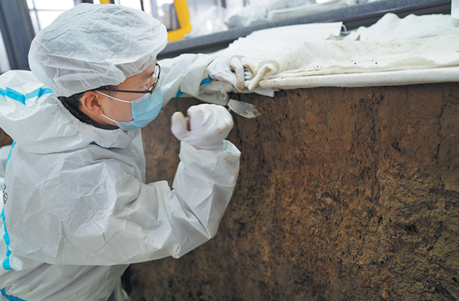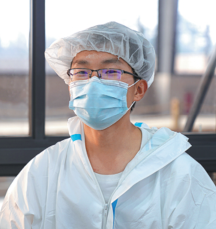Out with the old, in with the new
The work of one young Chinese archaeologist is capturing the imagination of his peers, breathing new life into old artifacts, Wang Xingwei reports.
"Pit Manager", that's the nickname of Xu Danyang, a 27-year-old archaeologist, as given by his colleagues.
Xu is a member of the archaeological team working at the Sanxingdui Ruins site in Deyang, Sichuan province, which provides glimpses of an ancient civilization dating back more than 3,000 years. Xu's nickname stems from the excavation of sacrificial pits at the site.
"After its excavation in 2020, I was assigned to Pit No 4 and became the team leader in charge of half a dozen people, so they started calling me 'Pit Manager'," Xu smiled.
The 3,000-year-old Sanxingdui Ruins are home to a large number of bronze statues, most of which were the first of their kind to be discovered in China. Among them were unique and huge objects, such as a peculiar "sky-reaching" bronze sacred tree, a dragon-shaped bronze statue with a "tiger head" and a standing figure appearing to look like the Japanese superhero Ultraman. These works have aroused people's curiosity and gone viral online, with many netizens also creating memes of the findings, giving their modern take on the ancient remains.
Initially, the popularity of the Sanxingdui site surprised Xu, but later he found out that many young people are interested in not only the site's bizarre-looking artifacts but also his painstaking archaeological work done there.
"At first, I wondered why people wanted to interview me. After all, I'm just a young, ordinary archaeologist. But later I found that many people now prefer to learn about archaeological findings from younger people," he said in a previous interview with China Daily.
In Xu's eyes, archaeology involves long-term devotion and any expectations for quick success or instant rewards should be left at the door. "It has been my good fortune to work at the Sanxingdui site, but the sensational discoveries my team has made could be seen as quite accidental," he said.
Speaking of the pit team, Xu says more than half the members were born in the 1990s. The daily work of Xu and his team can be split into two parts: the indoor work of reorganizing materials and conducting research, and the outdoor archaeological fieldwork, both of which require great meticulousness. Take archaeological excavations as an example. With countless relics in the sacrificial pits and the artifacts piled layer upon layer, the archaeological team cannot directly step into the pit in case they cause damage to the fragile treasures.
"After much trial and error, we came up with better ways of working," Xu said. Finally, they decided to use a suspended scaffold that people could lie on and go about their work.
But despite such careful planning, sometimes the weather lets them down. "Fieldwork is, of course, susceptible to natural conditions. It's heartbreaking to see some of our structures collapse due to heavy rain, making all our hard work in vain," Xu said.
But the archaeologists are never defeated by such difficulties since patience is a must-have quality for the job, Xu noted.
"Excavation at Sanxingdui actually goes back almost 90 years, and it took more than 30 years to make just two major discoveries," he said.
Known as one of the world's greatest archaeological findings of the 20th century, the Sanxingdui Ruins site was accidentally discovered by a farmer while digging a ditch in the 1920s. Large-scale excavations of the site began in 1986, when two pits — widely believed to be for sacrificial ceremonies — were accidentally discovered, making Sanxingdui famous around the world.
According to Xu, he is the third generation of Sanxingdui archaeologists. With the tremendous efforts of his generation and those before him, more and more relics have been brought to light. As the investigation work continues, the Sanxingdui site proves the existence of the ancient Shu civilization — a civilization dating back at least 4,800 years in Sichuan province.
"Now we can vividly feel how inclusive Chinese civilization was. It's not about the dominance of a single culture but about the common prosperity of different kinds of people," Xu said.
Moreover, some relics have shed light on the cultural exchanges between the ancient Shu civilization and other areas. "For example, the bronze figurine holding a zun vessel on top of its head combines distinctive regional characteristics and elements from the Yellow River civilization," Xu noted.
The findings help study a crucial question about the origins of Chinese civilization. When visiting the Chinese Academy of History in June, President Xi Jinping also emphasized the importance of archaeology in understanding the long history of Chinese civilization and appreciating the richness and profoundness of Chinese culture.
For Xu, President Xi's words have always served as an inspiration. Back in school as an archaeological student at Peking University, his reading of a letter Xi wrote to him and his fellow alumni made him even more determined to be an archaeologist.
"He showed huge support for what we were studying and encouraged us to dedicate our youth to where the country and people need us," Xu said.
Contact the writer at wangxingwei@i21st.cn





















